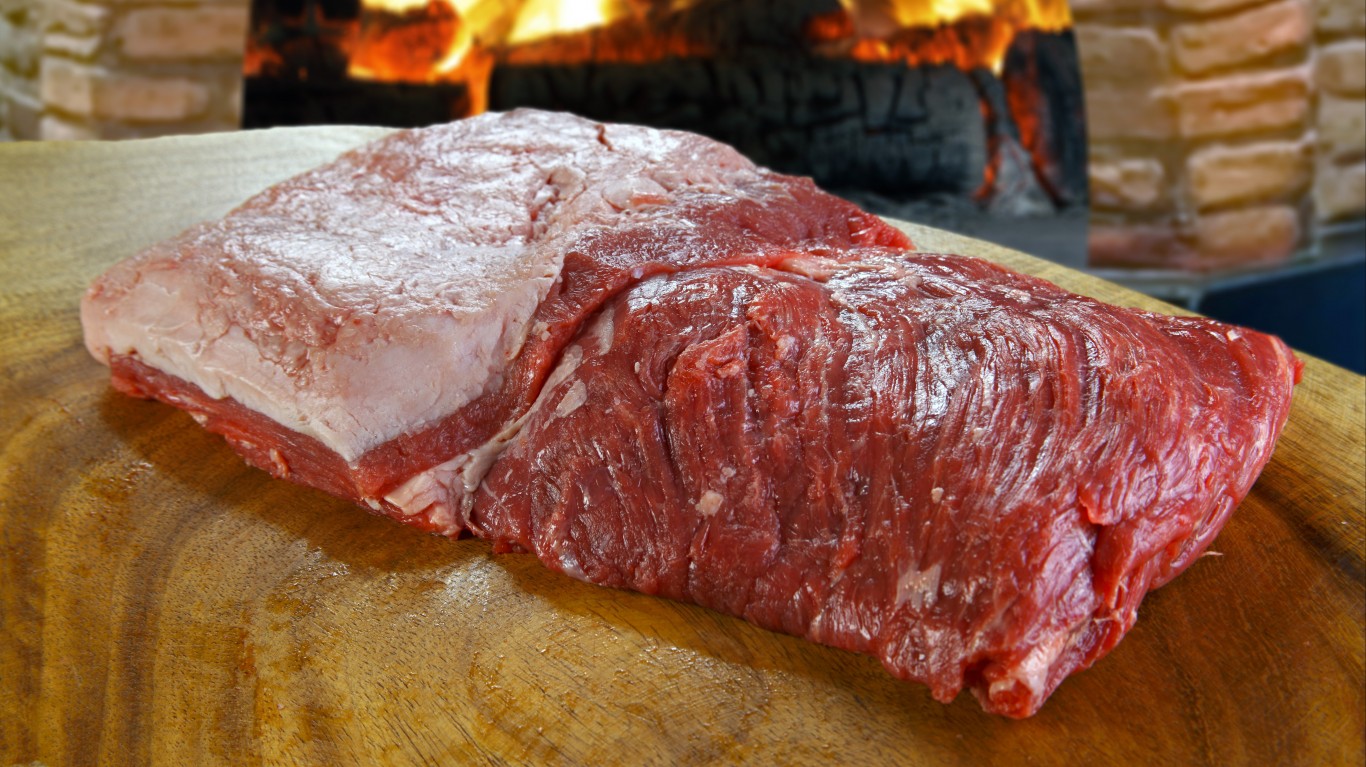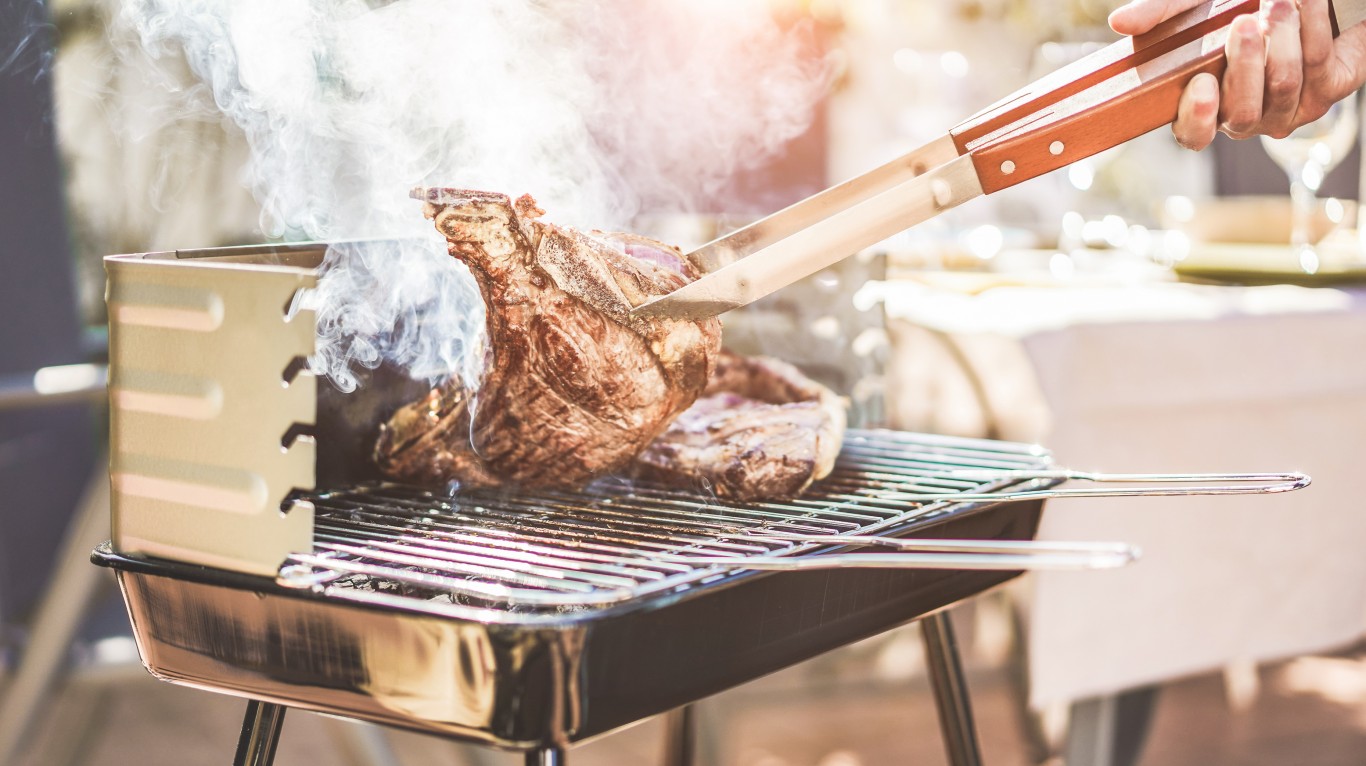Special Report
The Biggest Mistakes People Make Cooking Steak at Home

Published:
Last Updated:

Americans consumed an average of 56.9 pounds of beef and veal per person in 2017. How much of the beef was in the form of steak is hard to calculate, but judging from the proliferation of steakhouses around the country and the variety of steaks sold in supermarkets and butcher shops nationwide, it must be quite a bit.
Tastes in steak vary, of course — people like different cuts of meat, different degrees of doneness, different seasoning. Some steak-lovers go for pricey filet mignon or tenderloin, meat that’s always tender but sometimes not as flavorful as other cuts. Others swear by strip steaks or ribeyes, T-bones or porterhouses.
A trendy restaurant steak these days is the tomahawk, a thick cut of ribeye with a long exposed portion of bone attached, measuring 6 to 8 inches or more, which makes the whole thing look a little like a hatchet. If you want to try it, you may want to know about the most expensive steakhouses in every state.
To what doneness should a steak be cooked? That, too, is a matter of taste. Some people don’t want to see a hint of pink in their meat, even though well-done steaks tend to be dry and lacking in flavor. Others like their steak virtually raw inside — “I want to hear it moo,” goes an old joke — enclosed by just a thin seared exterior.
Many connoisseurs of steak consider the ideal to be one that’s more or less uniformly rare or nearly rare inside and nicely charred outside, with the flavorful brown crust that results from the process called the Maillard reaction, the same effect that gives bread its own brown crust and turns milk and sugar into caramel.
Cooking steak at home ought to be a straightforward process. A nice piece of meat, a hot pan or grill, some cooking fat or oil, some seasoning. What could be so hard about that? Yet home-cooked steaks rarely offer the juiciness and intensity of flavor that restaurant steaks do.
Click here for the biggest mistakes people make cooking steak at home.
There are several reasons for this, not least that restaurants are usually able to source meat of higher quality than the average consumer can buy. But home-cooked steaks often fall short for other, smaller reasons that are easy to correct. 24/7 Tempo has assembled a list of 10 steak mistakes, together with advice on how to avoid them.

1. Buying the wrong cut of meat
Just because it’s called “steak” doesn’t mean that a cut of meat will turn out tender and flavorful when it’s grilled or sautéed. Top round and bottom round steak, for instance, are lean and tough and are best cooked by braising or slow-cooking in liquid. Flank steak is another chewy cut, which can indeed be grilled (or broiled), but needs to be marinated first and then sliced thinly against the grain. The best cuts quick and simple preparation include strip steak, T-bone, porterhouse, ribeye, and filet mignon.
[in-text-ad]

2. Cooking it damp
One of the pleasures of a well-prepared steak is a crusty, caramelized exterior. Blotting both sides of the meat well with paper towels before cooking helps the crust form through the chemical process called the Maillard reaction — which won’t happen if there’s too much moisture on the surface.

3. Cooking it straight from the refrigerator — maybe
This one’s controversial. The common wisdom, as relayed by such authorities as Bon Appétit and Delish, is that you should always leave your steak out for 30 minutes or so, so that it comes to room temperature, which is said to make it easier to cook evenly. But the science behind this theory is shaky. First of all, it takes longer than half an hour to bring a good-size steak to room temperature throughout. And experiments have shown that cooking a steak cold yields basically the same results as cooking one that has warmed up. What to do? One thing that does seem true is that cold meat can seize up and toughen when heat is applied, so it might be a good idea to take the meat out of the refrigerator 20 minutes or so before cooking, so that at least the surface isn’t chilled.

4. Using the wrong kind of pan
Non-stick pans, stainless steel pans, enameled pans — they’re all useful cooking vessels for various purposes. Cooking steak is not one of them. If you can’t char your steak on a grill, the best pan is a cast-iron one. Cast-iron pans heat evenly and can stand up to very high heat; they require less oil or other cooking fat and become naturally non-stick over time; and they go easily from stovetop to oven. This is essential if you’re cooking your steak with the pan-to-oven method, which involves searing it for a couple of minutes on each side, then finishing it in the oven (about 15 minutes at 350º will bring an inch-and-a-half-thick steak to rare).
[in-text-ad-2]

5. Underseasoning it
Season your steak with more salt than you think it needs and with plenty of freshly ground black pepper. Some of it will come off as you cook the meat anyway, especially if you’re grilling it — but remember, too, that you’re only salt-and-peppering the surface of the meat, and when you take a bite of a nice thick steak, you’ll want enough seasoning to enhance the whole thing. Many chefs even season generously before cooking, and then season again when the steak comes off the fire — and they presumably know a thing or two about how to make meat taste good.

6. Not getting the pan or grill hot enough
One reason that steakhouse steaks usually taste better than home cooked one has to do with the intensity of heat with which the steak is cooked. Steakhouses that broil their meat (often in infrared ovens) generally do so at temperatures ranging from 750º to (in the case of Ruth’s Chris) 1800º — while the average home range seldom gets hotter than 550º. Restaurant grills and stovetops are usually considerably hotter than their home equivalents, too. You probably won’t be able to compete with this level of heat, but do get your own pan or grill (or oven) as hot as you possibly can if you want that caramelized crust.
[in-text-ad]

7. Using oil or fat with a low smoke point
Smoke point is the temperature at which a cooking oil or fat begins to smoke. If you’re planning to sear your steak for a couple of minutes on each side and then finish it in the oven, and if you don’t mind potentially setting off the smoke alarm, then extra-virgin olive oil or butter, both of which have a smoke point of around 350º, are fine to use. If you’re cooking the meat in a pan straight through, you’ll want something with a higher smoke point — like clarified butter, peanut oil, or corn oil, all of which begin smoking at 450º, or even safflower oil, whose smoke point is the highest of any common cooking medium at 510º. This is not just about setting off the smoke alarm. Smoking oil or fat breaks down and releases free radicals and a liquid called acrolein, which gives burnt foods a nasty flavor and aroma.

8. Not turning it enough
More controversy here: The conventional advice is that a piece of meat, steak or otherwise, should be turned only once while cooking — something about the way the juices move around inside the meat. Studies have shown that this is basically nonsense — and that flipping the steak numerous times as it cooks speeds up the process (by as much as 30%) and also cooks the meat more evenly. (Pro tip: Use tongs to turn the meat, not a fork; if you perforate the steak, you’ll lose some of those precious juices.)

9. Overcooking it
There is, as they say, no accounting for taste, and some people (one of whom is a current occupant of the White House) like their steak well-done — grayish-brown inside, with no hint of pink. There’s nothing wrong with that, as long as you enjoy dry, less than flavorful meat. Many carnivores prefer their steak rare or medium-rare, however. Being able to cook meat the way you like it is a matter of experience: One burner or grill may be slightly warmer or cooler than another, and steaks are cut to different thicknesses, so a certain amount of trial and error is inevitable. As a general rule, however, a steak that’s about one-and-a-half inches thick needs roughly 10 minutes of total grill or stovetop cooking time for rare, 12 or 13 minutes for medium-rare. If you prefer to use a meat thermometer, which isn’t a bad idea, cook your steak to an internal temperature of about 120º for rare, 130º for medium rare.
[in-text-ad-2]

10. Not resting it before serving
The steak is off the grill or out of the pan and smells so good you can’t wait to dig in. But you should wait. Put the meat on a warmed plate and just let it sit for a few minutes — at least three or four, maybe a few more. If you cut into a steak as soon as it’s finished cooking, juices will leak out, but if you give it a little time, the juices will be reabsorbed into the cells of the meat, leaving it, well, juicier.
Credit card companies are at war, handing out free rewards and benefits to win the best customers. A good cash back card can be worth thousands of dollars a year in free money, not to mention other perks like travel, insurance, and access to fancy lounges. See our top picks for the best credit cards today. You won’t want to miss some of these offers.
Flywheel Publishing has partnered with CardRatings for our coverage of credit card products. Flywheel Publishing and CardRatings may receive a commission from card issuers.
Thank you for reading! Have some feedback for us?
Contact the 24/7 Wall St. editorial team.